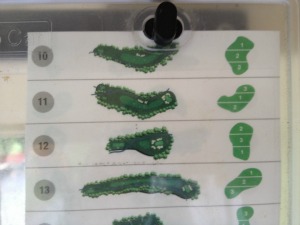Learn How To Master The Golf Mental Game
Can you conquer the golf mental game?
Before continuing, ask yourself this question: Am I my own worst enemy on the golf course? Initially, you might be inclined to say "no". Think a little harder, though.
How many times have you become so frustrated after a poor shot that it has completely ruined your next shot? What about the rest of the hole? How about the entire round?
If that sounds like you, then the golf mental game has you beat!
Obviously, if you have a high handicap there may be many other aspects that contribute to poor scores other than your thoughts and emotions. Becoming more mindful of yourself and your swing will allow you to practice more effectively and likely improve your skills in a much shorter time frame.
For those who already are excellent golfers, working on the mental aspect of golf will help improve your ability to focus allow you to take each shot one at a time. Being able to quickly move on from any mistakes is one of the main goals of this type of training.
This page is to serve as an overview of how to mentally prepare for golf. If you would like a more comprehensive resource, please continue look ahead to my review of the book, Golf Sense.
What You Need To Know About The Golf Mental Game
There are a handful of aspects to mental training. They include:
- Focus
- Relaxation
- Prevention
- Enjoyment
and
- Having a short memory!
Focus means that you truly honed in onto the task at hand. You can tune out anything else that is going on around you. On the golf course there can be all sorts of distractions, including: nature, golf carts, cars, and other golfers just to name a few.
When you grab your club from your bag, the only thought you should have is on the upcoming shot. Rehearse it in your head, and imagine exactly where it is going to go. Being able to block out everything else that is going on is essential!
When you approach the ball, relaxation is necessary to release any tension that you are storing up in your muscles. The main muscle group that you need to focus on is the upper trapezius muscles on either side of your neck. Many people carry tension through here, and if these muscles are tight, it could lead to altered mechanics during your swing. Also, making sure that your chest, arms, and back are loose will greatly aid your swing.
Prevention refers to making sure those old habits don't crop up during your swing. Developing a proper golf swing takes time and practice. Even professionals have lapses from time to time, so you can't expect to be perfect but if you can minimize these faults, it will pay huge dividends on the scorecard.
As you hit shot after shot, good or bad, you have to ultimately enjoy what you are doing. Enjoyment is a huge aspect to the golf mental game. It also goes hand in hand with the other aspects because once you lose that enjoyment, it becomes extremely difficult to succeed with the other areas.
Finally, having a short memory, will allow you to quickly forget about the previous shot. Taking each shot one at a time will remove any effect that frustration could have on your game. When you have a bad shot, your very next attempt becomes even that more important. Going into that shot angry or frustrated is a recipe for disaster! Hit two poor shots in a row and now you are really in trouble!
Course Management
A commonly overlooked aspect to the mental aspect of golf is proper course management. Being able to manage the golf course simply means that you handle almost every situation that will arise through mental preparation.
All of the things mentioned above play a role in managing the course. If you get upset or frustrated, and then carry that over from hole to hole, you will lose focus and your decision making will suffer.
Another huge component of management if familiarizing yourself with the golf course. This may be easy for your home course, but if you are playing some where new, its not a bad idea to research the course before playing, especially if you have something on the line. What this will do is make you generally aware of where to place your shots in order to set up your next shot. Now being able to look a few shots ahead takes skill and confidence, but you will certainly see lower scores by setting yourself up for success.
Specific things to look for when examining a course are:
- General orientation of each hole (ex. dogleg, uphill, downhill)
- Obstacles such as bunkers, trees, water hazards, out of bounds
- Pin placement
The orientation of a hole will dictate which club that you use, as well as where you would like to place each shot. Holes that slope downhill (particularly par 3's) will require you to choose a shorter club to hit the ball the same distance. Plus a general knowledge of where the hazards are located, especially those that aren't visible from the tee box, will help you be able to be more effective with your club selection.
For example, if you know there is a fairway bunker 250 yards from the tee box and you typically hit your driver 250 yards as well, choosing a 3 wood or even a long iron, will take away the risk of hitting that sand trap by sacrificing a few yards. This sets you up for a potentially better second shot.
Moving on to pin placement, many course will have a plaque or board either around the clubhouse or at the first tee telling you the pin placements for that particular day. Generally, they are broken down to either 1-2-3, which refers to a particular section of the green. Simply look at your scorecard and there should be a numerical map breaking down approximately where each one of those areas is.

Knowledge of pin placement will allow you to attack the pin and will
translate to lower scores by reducing the number of putts that you take
per round.
What also goes hand in hand with course management and being able to plan a shot or two ahead, is knowing yourself and your tendencies. Do you typically pull the ball the left? Well the compensate for it with your alignment! This type of thinking becomes very important on dogleg holes, or holes with obstacles/hazards. Knowing where the challenges are is one thing, but being able to compensate for your own habits in order get around those challenges is another!
Golf course management is extremely important and a very effective way to lower your scores. I fully intend on writing a more extensive article on this topic in the near future so please keep checking back in.
Resource For Mastering The Golf Mental Game
As a physical therapist, I do not claim to be an expert on mental training for performance. For this, I have turned to an expert in the field of mental training and performance, Roy Palmer.
Roy has authored numerous books on sports performance, but his book Golf Sense, should be considered one of premier resources for golfers looking to work on the mental aspect of the golf game.
The main goal of Golf Sense is to teach you how to get into "The Zone". The Zone is basically where you are in a completely relaxed state, yet solely focused on the task at hand. This allows you to effectively perform the golf swing over and over again, with a minimization of faults. Roy goes into incredible depth, explaining each step along the path to the Zone. He also provides you with many basic exercises to help you improve posture, breathing, focus, and more.
This book is for all ages, and skill levels as well. Everyone that reads this book will be able to find something that is able to help their swing and their overall game. After reading it myself, I have found that I am having a much easier time relaxing at address and have been able to clear my mind much easier after a bad shot.
Much of the basic information on this page has been adapted from Roy's teachings. His book breaks everything down into simple steps, and includes detailed illustrations to help you fully understand his tips and exercises.
Consider this page a teaser for Golf Sense! If you would like to learn more about performance and the golf mental game, I strongly recommend reading Roy Palmer's book.
Golf Sense is available in both paperback and Kindle formats:
Golf Fitness Home > Golf Swing Tips > Golf Mental Game






New! Comments
Have your say about what you just read! Leave me a comment in the box below.